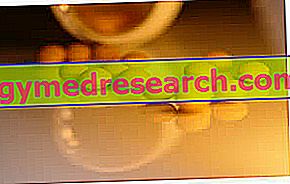Generality
Eosin is a chemical compound used in various fields as a dye and as a skin disinfectant .

In detail, eosin is a derivative of fluorescein, a molecule with green fluorescence used to produce other dyes - such as, precisely, eosin - as a pH indicator and even for performing fluorescence diagnostic tests .
However, from a chemical point of view, eosin properly called - also known as common eosin or eosin Y - is a tetrabromic derivative of fluorescein which appears as a red crystalline powder, soluble in water and alcohol, with green fluorescence.
Then there is another form of eosin, known in the common language as eosin scarlet or as eosin B. It is a brown crystalline powder, soluble in water, whose uses are similar to those of common eosine. From the chemical point of view, it differs from the latter in the presence of two nitric groups in place of two of the four bromine atoms present in the Y form. The latter, however, is the most exploited form of eosin.
In addition to use as a dye, eosin is also used in the medical-pharmaceutical field by virtue of its disinfectant action on the skin which is associated with the ability to favor healing when it is damaged, abraded or scalded.
In this article only the use of eosine in the medical field will be considered.
Examples of Medicinal Specialties Containing Eosin
- Neomercurocromo®
- Eosina NA®
- Eosina Pharma Trenta®
Therapeutic indications
When is the use of Eosina indicated?
The use of medicinal preparations based on eosin is indicated in the local treatment for the disinfection of:
- Small wounds;
- Burns;
- Abrasions;
- Insect bites;
- Bedsores and sores in general;
- Diaper rashes.
Did you know that ...
Within the medicinal preparations used for skin disinfection, eosin can be found either alone or in association with other active ingredients with properties similar to and / or complementary to those of eosin itself, useful for increasing the disinfectant action and / or healing of the final product.
Warnings
Warnings and precautions for the use of Eosina
There are no particular warnings or precautions to be taken before using eosin based medicinal preparations. However, it should be pointed out that these preparations must not come into contact with the eyes and must not even be applied near them.
Furthermore, it should be remembered that the treatment of wounds, burns, abrasions, insect bites and diaper rashes with eosin should only be performed for short periods of time . In the event that the skin conditions do not improve, or get worse, it is necessary to seek advice from your doctor.
Pharmacological Interactions
Eosin interaction with other drugs
To date (2018) there are no known drug interactions between eosin-based medicines and other types of drugs.
However, before using eosin to disinfect the skin, it is still advisable to inform your doctor if you are taking / using - or if you have recently been / used - drugs of any kind, including non-prescription medicines (SOP ), over-the-counter drugs (OTC), herbal and herbal products and homeopathic products, all the more so in the form of preparations to be applied to the skin.
Side effects
Side Effects Caused by the Assumption of Eosin
Although normally well tolerated, eosin has the potential to cause side effects, although not all patients manifest them or manifest them in the same way. In fact, each individual reacts differently to the application of the drug in question.
However, the main side effects that may occur following the application of eosine on the skin consist of contact dermatitis and hypersensitivity reactions in susceptible and sensitive subjects.
Overdose
Given the mode of application, no cases of eosin overdose have been reported at this time. However, in case of accidental ingestion of the drug, it is necessary to contact the doctor immediately or go to the nearest emergency room, taking the medicine pack with him.
Action mechanism
How does Eosin use?
Eosine is able to carry out the disinfection action of the skin by virtue of its bacteriostatic properties - practiced mostly against Gram-positive - and fungistatic - bacteria, in particular, against fungi belonging to the genus Candida . In addition, eosin is also endowed with anti-exuding activity, through which there is a reduction in the secretion of exudate, thus favoring the healing and re-epithelialization of wounded, abraded or scalded skin.
Method of use and Posology
How to take Eosin
Eosin as a skin disinfectant is available, of course, in formulations suitable for topical use and, in particular, for cutaneous application. In detail, eosin is available in the form of a cutaneous solution in concentrations of 1% or 2% .
Generally, it is recommended to apply one or two drops of the drug once or twice a day. The drops can be poured directly on the area of the affected skin, or they can be previously poured onto a sterile gauze with which it will then have to dab the skin that is to be disinfected. If necessary, it is also possible to cover the treated area with an appropriate bandage that is sterile and dry.
Warning!
As mentioned at the beginning of the article, eosin is a dye having a reducing action. Because of this activity, when the active ingredient comes into contact with healthy skin, it causes red spots with golden reflections which, however, disappear within a few days. Therefore, the appearance of spots of this type can be considered normal and should not cause concern.
Pregnancy and breastfeeding
Can Eosin be taken during pregnancy and during breastfeeding?
Even if used on damaged skin, normally, the systemic absorption of eosin is negligible ; therefore, there should be no risk of adverse effects in the fetus or infant. However, as a precaution, pregnant women and breastfeeding mothers should seek the advice of a doctor before using eosin to disinfect their skin, just as they should seek the advice of this health figure before taking on any kind of drug or natural product.
Contraindications
When Eosin should not be used
The use of eosine for skin disinfection is contraindicated in all those people with known hypersensitivity to eosin itself and to any other active and / or excipient substance contained within the medicinal product to be used.
Other Uses
As mentioned, in addition to the medical-pharmaceutical field, eosin is also used in many other fields, such as those reported below.
Cosmetic Industry
Eosin is used in the cosmetic industry as a dye, generally in lipsticks and other lip make-up products.
Food industry
As in the field of cosmetics, even in the food industry eosin is used as a dye, especially for sweets and liqueurs.
Other Industrial Uses
Eosin is used as a red dye even in the production of pens and in the composition of lacquers.
Histology and Bacteriology
The coloring properties of eosine are also used in the field of histology - where it is used for the coloring of granulocyte eosinophils, but also in the cytoplasm - and in the field of bacteriology, where eosin is used as an indirect dye in the study of bacterial cells .



